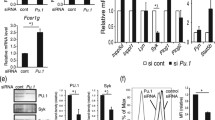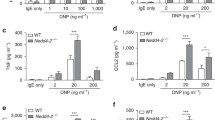Abstract
The high-affinity receptor for immunoglobulin E (IgE), FcεRI, is specifically expressed in mast cells and basophils and plays a key role in IgE-mediated allergic reactions. The transcription factor Elf-1 has been previously identified to bind to the promoter of the human FcεRI α-chain, which is essential for the function and expression of FcεRI. In the present study, Elf-1 siRNA was conducted to evaluate the effects of Elf-1 on FcεRI α-chain expression in the primary mouse mast cells, bone marrow-derived mast cells (BMMC). Introduction of Elf-1 siRNA effectively reduced expression levels of Elf-1 mRNA and protein in BMMC. Transient reporter assay showed that the knockdown of Elf-1 by siRNA resulted in increased FcεRI α-chain promoter activity, while overexpression of Elf-1 suppressed α-chain promoter activity in BMMC. Elf-1 siRNA-treated BMMC exhibited marked upregulation of FcεRI α-chain transcription, whereas β-chain mRNA was not affected by Elf-1 siRNA. Chromatin immunoprecipitation assay showed that the amount of transcription factor PU.1, recognizing the cis-element close to the Elf-1-site on the FcεRI α-chain promoter, was significantly increased by introduction of Elf-1 siRNA. These results indicate that Elf-1 negatively regulates FcεRI α-chain expression by suppressing PU.1-mediated transcription of the α-chain in BMMC.




Similar content being viewed by others
Abbreviations
- BMMC:
-
bone marrow-derived mast cells
- ChIP:
-
chromatin immunoprecipitation
- Ct:
-
cycle threschold
- EMSA:
-
electrophoretic mobility shift assay
References
Bockamp E-O, Fordham JL, Gottgens B, Murrell AM, Sanchez M-J, Green AR (1998) Transcriptional regulation of the stem cell leukemia gene by PU.1 and Elf-1. J Biol Chem 273:29032–29042 doi:10.1074/jbc.273.44.29032
Dombrowicz D, Flamand V, Brigman KK, Koller BH, Kinet J-P (1993) Abolition of anaphylaxis by targeted disruption of the high affinity immunoglobulin E receptor alpha chain gene. Cell 75:969–976 doi:10.1016/0092-8674(93)90540-7
Geng Y, Laslo P, Barton K, Wang C-R (2005) Transcriptional regulation of CD1D by Ets family transcription factors. J Immunol 175:1022–1029
Grant PA, Thompson CB, Pettersson S (1995) IgM receptor-mediated transactivation of the IgH 3′ enhancer couples a novel Elf-1-AP-1 protein complex to the development control of enhancer function. EMBO J 14:4501–4513
Hasegawa M, Nishiyama C, Nishiyama M, Akizawa Y, Takahashi K, Ito T et al (2003) Regulation of the human FcepsilonRI alpha-chain distal promoter. J Immunol 170:3732–3738
Ito T, Nishiyama C, Nishiyama M, Matsuda H, Maeda K, Akizawa Y et al (2005) Mast cells acquire monocyte-specific gene expression and monocyte-like morphology by overproduction of PU.1. J Immunol 174:376–383
John S, Robbins CM, Leonard WJ (1996) An IL-2 response element in the human IL-2 receptor alpha chain promoter is a composite element that binds Stat5, Elf-1, HMG-I(Y) and a GATA family protein. EMBO J 15:5627–5635
Juang Y-T, Sumibcay L, Tolnay M, Wang Y, Kyttaris VC, Tsokos GC (2007) Elf-1 binds to GGAA elements on the FcRgamma promoter and repress its expression. J Immunol 179:4884–4889
Leiden JM, Wang C-Y, Petryniak B, Markovitz DM, Nabel GJ, Thompson CB (1992) A novel Ets-related transcription factor, Elf-1, binds to human immunodeficiency virus type 2 regulatory elements that are required for inducible trans activation in T cells. J Virol 66:5890–5897
Maeda K, Nishiyama C, Tokura T, Akizawa Y, Nishiyama M, Ogawa H et al (2003) Regulation of cell type-specific mouse FcepsilonRI beta-chain gene expression by GATA-1 via four GATA motifs in the promoter. J Immunol 170:334–340
Maeda K, Nishiyama C, Tokura T, Nakano H, Kanada S, Nishiyama M et al (2006) FOG-1 represses GATA-1-dependent FcepsilonRI beta-chain transcription: transcriptional mechanism of mast-cell-specific gene expression in mice. Blood 108:262–269 doi:10.1182/blood-2005-07-2878
Nakahata T, Spicer SS, Cantey JR, Ogawa M (1982) Clonal assay of mouse mast cell colonies in methylcellulose culture. Blood 60:352–361
Nimer S, Zhang J, Avraham H, Miyazaki Y (1996a) Transcriptional regulation of interleukin-3 expression in megakaryocyte. Blood 88:66–74
Nimer SD, Zhang W, Kwan K, Wang Y, Zhang J (1996b) Adjacent, cooperative elements from a strong, constitutive enhancer in the human granulocyte-macrophage colony-stimulating factor gene. Blood 87:3694–3703
Nishiyama C, Yokota T, Okumura K, Ra C (1999) The transcription factors Elf-1 and GATA-1 bind to cell-specific enhancer elements of human high-affinity IgE receptor alpha-chain. J Immunol 163:623–630
Nishiyama C, Hasegawa M, Nishiyama M, Takahashi K, Yokota T, Okumura K et al (2001) Cloning of full length genomic DNA encoding human FcepsilonRI alpha-chain and its transcriptional regulation. Biochem Biophys Res Commun 284:1056–1064 doi:10.1006/bbrc.2001.5079
Nishiyama C, Hasegawa M, Nishiyama M, Takahashi K, Akizawa Y, Yokota T et al (2002) Regulation of human FcepsilonRI alpha-chain gene expression by multiple transcription factors. J Immunol 168:4546–4552
Oettgen P, Akbarali Y, Boltax J, Best J, Kunsch C, Libermann TA (1996) Characterization of NERF, a novel transcription factor related to the Ets factor Elf-1. Mol Cell Biol 16:5091–5106
Siegel MD, Zhang D-H, Ray P, Ray A (1995) Activation of the interleukin-5 promoter by cAMP in murine EL-4 cells requires the GATA-3 and CLE0 elements. J Biol Chem 270:24548–24555 doi:10.1074/jbc.270.41.24548
Thompson CB, Wang C-Y, Ho I-C, Bohjanen PR, Petryniak B, June CH et al (1992) cis-Acting sequences required for inducible interleukin-2 enhancer function bind a novel Ets-related protein, Elf-1. Mol Cell Biol 12:1043–1053
Wang C-Y, Bassuk AG, Boise LH, Thompson CB, Bravo R, Leiden JM (1994) Activation of the granulocyte-macrophage colony-stimulating factor promoter in T cells requires cooperative binding of Elf-1 and AP-1 transcription factors. Mol Cell Biol 14:1153–1159
Wurster A, Siu G, Leiden JM, Hedrick SM (1994) Elf-1 binds to a critical element in a second CD4 enhancer. Mol Cell Biol 14:6452–6463
Acknowledgments
We would like to thank members of the Atopy (Allergy) Research Center and the Department of Immunology for helpful discussions. We are grateful for Drs. Y. Niwa, T. Fukai, and D. Potaczek for their technical assistance and Ms. M. Matsumoto for secretarial assistance. This work was supported in part by a grant-in-aid for Scientific Research (C) from the Ministry of Education, Culture, Sports, Science and Technology of Japan (to C. N.).
Author information
Authors and Affiliations
Corresponding author
Rights and permissions
About this article
Cite this article
Wang, Qh., Nishiyama, C., Nakano, N. et al. Suppressive effect of Elf-1 on FcεRI α-chain expression in primary mast cells. Immunogenetics 60, 557–563 (2008). https://doi.org/10.1007/s00251-008-0318-y
Received:
Accepted:
Published:
Issue Date:
DOI: https://doi.org/10.1007/s00251-008-0318-y




